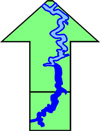
Upper Monongahela River Association
Menu
Visions
Visions
This section of the UMRA website contains information which we think can help visitors develop a broader appreciation of both the future of America's rivers and the Monongahela River in particular.
Westover-Stansbury Hall Riverfront Project, Julie Kagler, Daniel Proudfoot, and Madeleine Hoden, December 2008(1858K .PDF file) - High resolution version for detailed study (8787K .PDF file)
During the Fall 2008 Semester WVU Students Julie Kagler, Daniel Proudfoot, and Madeleine Hoden conducted a design project in which they studied posibilities for developments in the Point Marion Pool (Morgantown area) which could improve aesthetics, improve recreational access and improve fish habitat and other ecological functions and services. The focussed on the portion close to the WVU (West Virginia University) campus. The links above contain a .PDF version of their PowerPoint presentation to the Office of the WVU President on 12 December 2008.
Boat Crew Operation of River Thames Locks, Wallace Venable, April 2006 (325K .PDF file)
On the River Thames, in England, pleasure vessel crews may operate large locks themselves when the professional lockmaster is not on duty. This report of a personal cruise gives a summary of a prodedure which might be used in North America.
A Vision for VanVoorhis , Strimbeck, Shuck & Venable, April 2004 (520K .PDF file)
The Quality Glass Company site at Monongahela River Mile 95 offers Monongalia County a great opportunity to improve river access. We offer our thoughts on the potential. This factory site is recognized as significantly polluted with chemicals used in making glass lighting products.
Transient Non-Trailerable Boat Facilities - A Plan for the Upper Monongahela in West Virginia , Strimbeck, Shuck & Venable, August, 2002 (6.2M .PDF file)
We did this work in order to speed thinking on a Boating Infrastructure Grant (BIG) application by the Upper Monongahela River Water Trail SIG of Vision 2020 of the Morgantown Area Chamber of Commerce. The purpose is to install public docks and other shore-side facilities and attractions for transient non-trailerable boats. The BIG program provides funding on a 75%-25% matching basis. Facilities muse be targeted for boats over 25 feet in length, and be primarily for short term use. Funding is derived from Federal taxes on fuel used by pleasure boats.
In support of this effort we concluded that the use of the Upper Monongahela by transient non-trailerable boats would increase if the following facilities were constructed:
A day dock at Morgantown (Hazel Ruby McQuain) Riverfront Park
A day dock at Pricketts Fort State Park
An overnight dock at Rivesville, West Virginia
A day dock at Fairmont, West Virginia
Improvements to the docking facilities at Star City (Edith Barrill) Riverfront Park
Upper Monongahela River Automation Study - Pittsburgh District Corps of Engineers - March 2004
(The link above connects to a scanned copy of the report on this site.)
The 2004 Energy and Water Development Appropriations Act provided $342,000 for the Corps of Engineers to examine the practicality of remote control automation devices at the Hildebrand, Morgantown, and Opekiska Locks.
This report is an interim document in response to the Appropriations Act reporting requirement.
This interim report first addresses the merits of automation of the upper Monongahela facilities, the Morgantown, Hildebrand, and Opekiska Locks and Dams, operated by the Corps of Engineers, Pittsburgh District. It is followed up with a more detailed analysis of the full practicality of automation. Efforts for this study have concentrated at this time on the capacity to successfully engineer conceptual plans/alternatives for the automation of the Morgantown, Hildebrand, and Opekiska Locks and Dams and the future requirements to implement those plans and alternatives.
The report concludes that a tremendous need and opportunity exists to automate the Upper Monongahela River. A need exists for increased operating time for recreational boaters. Remote operations are practical and operable. The process of automation could provide increased service during a period of decreasing operating funds.
Environmental Advantages of Inland Barge Transportation, U.S. Department of Transportation, Maritime Administration, August 1994
The original and official version of this document is available on the Web from US Government resources. The original distribution is as a .PDF file of page images of a Courier typescript, not characters, so it is huge in size. This version consists of OCR scans, and is not edited except changes in typography. Missing ages 1-4, 27 were probably blank. This compacted file has been produced because we think it deserves a much wider readership.
Freight And The Environment: Effects Of Trade Liberalisation And Transport Sector Reforms, Organisation For Economic Co-Operation And Development, Paris, 1997, "Environmental Effects Of Changes In International Freight Movements Associated With Trade Liberalisation And Structural Reform In The Transport Sector" Section IV. A. covers the North American experience, IV. B. covers the European experience. It is also available in French.
Sometimes it is easier to see things clearly from a distance. This European report has perhaps the best summary of the strengths and weaknesses of US waterways thinking which is accessible to the public.